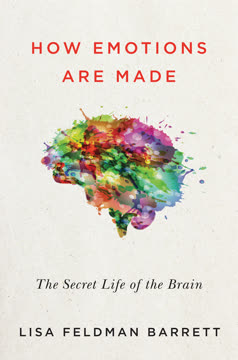Key Takeaways
1. Emotions precede feelings and are essential for survival
Emotions play out in the theater of the body. Feelings play out in the theater of the mind.
Evolutionary advantage. Emotions emerged first in evolution as automated, largely unconscious responses to promote survival. They involve complex sets of chemical and neural responses forming distinctive patterns. Emotions prepare the organism for action through changes in the body and brain.
Types of emotions. There are different levels of emotional responses:
- Basic homeostatic regulation (e.g. metabolism, immune responses)
- Pain and pleasure behaviors
- Drives and motivations (e.g. hunger, thirst)
- Primary emotions (e.g. fear, anger, disgust, joy)
- Social emotions (e.g. sympathy, embarrassment, pride)
Emotion-feeling cycle. Emotions trigger bodily changes, which are then perceived as feelings. This allows the organism to be aware of its internal state and react accordingly. The cycle of emotion leading to feeling provides an evolutionary advantage by allowing more flexible and creative responses to environmental challenges.
2. The brain's body-sensing regions are crucial for generating feelings
Feelings are based on composite representations of the state of life in the process of being adjusted for survival in a state of optimal operations.
Key brain regions. Several brain areas are critical for generating feelings:
- Insular cortex
- Somatosensory cortices (S1, S2)
- Cingulate cortex
- Brainstem nuclei
- Hypothalamus
Mapping the body. These regions create neural maps of the body's current state, including internal organs, muscles, and chemical parameters. The insula is particularly important, receiving signals about pain, temperature, visceral sensations, and other bodily states.
Feeling emergence. Feelings arise when the accumulation of mapped bodily details reaches a certain level of complexity. This allows the organism to have a mental representation of its overall state, which can then influence decision-making and behavior. The process involves both actual body states and simulated states, allowing for empathy and imagination.
3. Feelings provide a mental representation of the body's state
Feelings are the mental manifestations of balance and harmony, of disharmony and discord.
Bodily origin. Feelings are fundamentally rooted in the body. They represent the current state of the organism, including internal milieu, viscera, musculoskeletal system, and drives. This bodily grounding gives feelings their characteristic qualities and intensities.
Types of feelings. Damasio distinguishes between:
- Background feelings (overall body state)
- Primary feelings (tied to basic emotions)
- Social feelings (more complex, culturally influenced)
Cognitive integration. Feelings become integrated with thoughts, memories, and perceptions. This allows for:
- Evaluation of situations
- Decision-making based on predicted outcomes
- Regulation of social behavior
- Self-awareness and consciousness
The mental nature of feelings, grounded in body representations, allows organisms to "know" their internal state and use this information to guide behavior in complex ways.
4. Social emotions and feelings are foundational for ethical behavior
With naked eyes and a slew of scientific probes, an observer may objectively examine the behaviors that make up an emotion.
Evolutionary roots. Social emotions like sympathy, guilt, and pride have evolutionary precursors in other species. They emerged to facilitate group cooperation and social bonding.
Key social emotions:
- Sympathy/compassion
- Embarrassment/shame/guilt
- Pride
- Gratitude
- Indignation
Ethical implications. These emotions provide the basis for moral intuitions and ethical behavior. They motivate altruism, adherence to social norms, and concern for others' welfare. Damage to brain regions involved in social emotions can lead to antisocial behavior and impaired moral reasoning.
Cultural shaping. While social emotions have biological roots, they are also shaped by culture and individual experience. This allows for the development of complex ethical systems and social institutions.
5. Damage to specific brain regions impairs decision-making and social conduct
We have emotions first and feelings after because evolution came up with emotions first and feelings later.
Ventromedial prefrontal cortex. Damage to this region impairs:
- Social decision-making
- Emotional processing
- Future planning
- Moral judgment
Case studies. Patients with such damage may have intact general intelligence but show poor judgment in personal and social matters. They often make disadvantageous decisions and have difficulty with social relationships.
Somatic marker hypothesis. Damasio proposes that the ventromedial prefrontal cortex links past emotional experiences with decision-making. Without this connection, patients struggle to use emotional information to guide choices.
Developmental impact. Early damage to these regions can lead to severe antisocial behavior and failure to develop normal moral reasoning, highlighting the crucial role of emotions in ethical development.
6. Spinoza's philosophy aligns with modern neuroscience insights on emotions and ethics
The first foundation of virtue is the endeavor (conatum) to preserve the individual self, and happiness consists in the human capacity to preserve its self.
Mind-body unity. Spinoza rejected Cartesian dualism, viewing mind and body as two aspects of a single substance. This aligns with modern neuroscience's understanding of the mind as emerging from bodily processes.
Emotions and reason. Spinoza saw emotions as natural phenomena to be understood, not suppressed. He believed that understanding our emotions could lead to greater freedom and ethical behavior.
Key Spinozian concepts that align with neuroscience:
- Conatus (self-preservation drive)
- Affects (emotions and feelings) as bodily modifications
- Ethics grounded in understanding of human nature
Ethical implications. Both Spinoza and modern neuroscience suggest that ethical behavior arises from understanding our emotional nature, not from pure reason alone. This has implications for moral education and social policy.
7. Understanding emotions and feelings has practical implications for personal and social well-being
Knowing about emotion, feeling, and their workings does matter to how we live.
Personal well-being. Understanding the neurobiology of emotions can help individuals:
- Regulate their emotional states more effectively
- Make better decisions by integrating emotional information
- Develop greater empathy and social skills
Clinical applications. This knowledge is leading to improved treatments for:
- Depression
- Anxiety disorders
- Addiction
- Pain management
Social implications. At a societal level, understanding emotions can inform:
- Educational practices
- Legal and political systems
- Conflict resolution strategies
- Public health policies
Ethical considerations. As we gain more control over our emotional lives through neuroscience and technology, new ethical questions arise about the nature of authenticity, free will, and human flourishing. Balancing scientific insights with humanistic values remains an ongoing challenge.
Last updated:
FAQ
What's Looking for Spinoza about?
- Exploration of Feelings: The book investigates the nature of feelings and emotions, focusing on their biological underpinnings and their role in the mind-body connection.
- Spinoza's Influence: António Damásio connects his findings to Baruch Spinoza's philosophy, highlighting the relevance of Spinoza's ideas on emotions and human behavior.
- Neuroscience and Emotion: Damásio uses contemporary neuroscience to explain how emotions and feelings arise from brain activity and body states, bridging the gap between philosophy and biology.
Why should I read Looking for Spinoza?
- Interdisciplinary Insights: The book combines philosophy, neuroscience, and psychology, offering a comprehensive view of human emotions and their impact on behavior.
- Practical Applications: Understanding the mechanisms behind feelings can aid in addressing mental health issues and improving emotional regulation.
- Engaging Narrative: Damásio presents complex ideas in an accessible manner, making the book engaging for both scholars and general readers.
What are the key takeaways of Looking for Spinoza?
- Feelings as Body Maps: Damásio posits that feelings are perceptions of body states, represented in the brain's body maps, emphasizing the connection between physical sensations and emotional experiences.
- Emotion Precedes Feeling: The book argues that emotions occur before feelings, with feelings being the brain's interpretation of emotional states.
- Role of Homeostasis: Feelings are tied to the body's homeostatic processes, highlighting the importance of maintaining balance for emotional well-being.
How does António Damásio define feelings in Looking for Spinoza?
- Perception of Body State: Feelings are defined as the perception of a certain state of the body, along with a certain mode of thinking.
- Interactive Process: Feelings are interactive perceptions that can influence thoughts and behaviors, highlighting their dynamic nature.
- Complexity of Feelings: They can arise from various sources, including emotions, appetites, and bodily states, reflecting the multifaceted nature of human experience.
What role do emotions play in decision-making according to Looking for Spinoza?
- Emotional Signals: Emotions provide critical signals that guide decision-making processes, helping individuals navigate complex social situations.
- Somatic Marker Hypothesis: Emotional responses influence reasoning, allowing past emotional experiences to inform future decisions.
- Impact of Brain Damage: Damage to brain regions responsible for emotions can impair decision-making, illustrating the importance of emotional awareness.
How does Looking for Spinoza connect feelings to social behavior?
- Feelings as Social Navigators: Feelings guide responses to others, with emotions like empathy and compassion being essential for maintaining social bonds.
- Consequences of Emotional Impairment: Individuals with emotional impairments struggle with social behavior, underscoring the importance of emotions in fostering healthy relationships.
- Cultural Implications: Understanding feelings can lead to better social governance and ethical behavior, promoting well-being and cooperation.
What is the significance of Spinoza in Looking for Spinoza?
- Philosophical Foundation: Spinoza's ideas provide a framework for understanding emotions and feelings, illustrating the historical context of emotional theory.
- Conatus and Virtue: Spinoza's concept of conatus, the drive for self-preservation, is foundational to virtue, emphasizing the biological basis of ethical behavior.
- Relevance to Modern Science: Spinoza's insights remain relevant in contemporary discussions of neuroscience and psychology.
How does Looking for Spinoza address the mind-body problem?
- Integration of Mind and Body: Damásio explores the relationship between emotions, feelings, and bodily states, suggesting they are interconnected.
- Neuroscientific Evidence: Findings support the idea that feelings arise from bodily states, reinforcing the notion that mental processes are grounded in physical experiences.
- Philosophical Implications: The book contributes to ongoing debates in philosophy and science, encouraging readers to reconsider the nature of consciousness.
How does Looking for Spinoza relate to modern neuroscience?
- Neuroscientific Evidence: Damásio integrates findings from neuroscience to support his philosophical arguments, particularly regarding emotions in decision-making.
- Emotional Processing: The book explores how emotions are processed in the brain, highlighting the significance of structures like the amygdala and prefrontal cortex.
- Implications for Mental Health: Insights suggest that understanding the neurobiology of emotions can lead to better therapeutic approaches.
How does Looking for Spinoza define feelings and emotions?
- Definitions: Emotions are biological responses to stimuli, while feelings are the conscious awareness of those emotions.
- Role in Behavior: Feelings guide behavior and decision-making, clarifying how we experience and respond to the world.
- Impact on Memory: Feelings influence memory and learning, with emotionally charged experiences being more likely to be remembered.
How does Looking for Spinoza address the concept of joy?
- Joy as a Goal: Joy is a fundamental aspect of human experience and a key component of a fulfilling life.
- Emotional Regulation: Strategies for cultivating joy and managing negative emotions are discussed, enhancing well-being.
- Biological Basis: The neurobiological underpinnings of joy are explored, linking it to specific brain regions and neurotransmitters.
What practical advice does Looking for Spinoza offer for emotional well-being?
- Emotional Awareness: Cultivating awareness of emotions and feelings can improve decision-making and overall well-being.
- Seeking Joy: Actively seeking joy and positive experiences while minimizing negative stimuli is advocated.
- Integration of Knowledge: Integrating knowledge from neuroscience and philosophy can enhance emotional regulation and coping strategies.
Review Summary
Looking for Spinoza: Joy, Sorrow, and the Feeling Brain explores the neurobiological basis of emotions and feelings, connecting modern neuroscience with Spinoza's philosophy. Readers appreciate Damasio's integration of science and philosophy, finding his explanations of brain function and emotional processes insightful. Some praise his writing style and depth of knowledge, while others find parts overly technical or repetitive. The book's exploration of Spinoza's life and ideas receives mixed reactions, with some finding it fascinating and others less relevant. Overall, reviewers value the book's contribution to understanding the relationship between mind, body, and emotions.
Similar Books










Download PDF
Download EPUB
.epub digital book format is ideal for reading ebooks on phones, tablets, and e-readers.








